|

Archaeological Museum of Delos The
Archaeological Museum of Delos
houses the abundant finds from the excavations on Delos
conducted by the French Archeological School at Athens since
the end of the 19th-century. Particularly important is the
collection of marble sculptures, with works from the early
Archaic period until Roman Imperial times. Judging from the
surviving pedestals at Delos, there were many bonze statues
too, although almost none have survived.
Click on the thumbnails below in order to see pictures of the Delos Museum. Use your browser's back button
to return to this page.

|
|
|
|
|
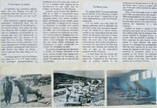 Information regarding the Naxian Lions. Incidentally, the lion casts were not
in place in September 2000 since that is precisely when we visited Delos.
All we saw at the site were the empty
pedestals.
Information regarding the Naxian Lions. Incidentally, the lion casts were not
in place in September 2000 since that is precisely when we visited Delos.
All we saw at the site were the empty
pedestals. |
|
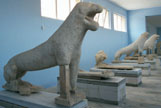 The
marble lions dedicated to Apollo by the Naxians at the end of 7th century
BCE originally stood in a row facing eastwards, towards the Sacred Lake.
They are the survivors of a line of at least nine lions, perhaps as many
as 16, but only five
lions and the remains of three more, standing on modern bases, can be seen
today. The headless body of another lion, removed in the 17th century, decorates the Arsenal in
Venice. The
marble lions dedicated to Apollo by the Naxians at the end of 7th century
BCE originally stood in a row facing eastwards, towards the Sacred Lake.
They are the survivors of a line of at least nine lions, perhaps as many
as 16, but only five
lions and the remains of three more, standing on modern bases, can be seen
today. The headless body of another lion, removed in the 17th century, decorates the Arsenal in
Venice. |
|
 Close-up
of a Naxian marble lion. Bordering the west side of the road leading from the harbor in
Skardana bay to the temples, they were the eternal guardians of the
Sanctuary. They lined the avenue in a manner only encountered in the
Orient and Egypt. The lions crouch on their
hind limbs, their tails between their legs. With their massive front part
thrust menacingly to the fore, they inspire divine awe in the visitor. Close-up
of a Naxian marble lion. Bordering the west side of the road leading from the harbor in
Skardana bay to the temples, they were the eternal guardians of the
Sanctuary. They lined the avenue in a manner only encountered in the
Orient and Egypt. The lions crouch on their
hind limbs, their tails between their legs. With their massive front part
thrust menacingly to the fore, they inspire divine awe in the visitor. |
|
|
|
|
|
 Well-preserved
group
of Artemis slaying a deer. Well-preserved
group
of Artemis slaying a deer. |
|
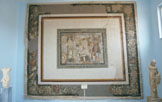 Mosaic
floor from a house on the hill. The vegetal motifs, guilloches and
vine branches with leaves and grapes, are rendered in a strikingly
naturalistic manner with bull heads and masks of the New Comedy
characters. Mosaic
floor from a house on the hill. The vegetal motifs, guilloches and
vine branches with leaves and grapes, are rendered in a strikingly
naturalistic manner with bull heads and masks of the New Comedy
characters. |
|
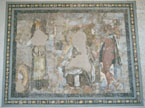 The
central representation of the mosaic floor contains three figures - Athena
in armor and helmet, Hermes in chlamys and petasos, and a majestic seated
figure that cannot be identified due to damage. The
central representation of the mosaic floor contains three figures - Athena
in armor and helmet, Hermes in chlamys and petasos, and a majestic seated
figure that cannot be identified due to damage. |
|
|
|
|
|
 Statue
associated with Dionysus. It represents an actor dressed as Papposilenus
in sheepskin and himation. His bald head is wreathed with ivy and he holds
a drum and a wineskin in his hands. Statue
associated with Dionysus. It represents an actor dressed as Papposilenus
in sheepskin and himation. His bald head is wreathed with ivy and he holds
a drum and a wineskin in his hands. |
|
 Artemis
wearing a chiton and a peplos with an over fold (apoptygma), after a known
5th century BCE type. The baldric on her chest held her quiver. Traces of
color are still preserved on the surface of the work. Artemis
wearing a chiton and a peplos with an over fold (apoptygma), after a known
5th century BCE type. The baldric on her chest held her quiver. Traces of
color are still preserved on the surface of the work. |
|
 Marble statue of Apollo.
The relaxed pose of the small nude Apollo Lykios recalls works by the great
sculptor Praxiteles. The god is represented leaning on a tree and stepping
on three Galatian shields. It is probably a smaller copy of the statue
dedicated to Delphi to commemorate a victory
against the Galls who attacked the Delphic Sanctuary in 279/278 BCE. It was
found in a private house in the Theatre Quarter and dates from the 2nd
century BCE. Marble statue of Apollo.
The relaxed pose of the small nude Apollo Lykios recalls works by the great
sculptor Praxiteles. The god is represented leaning on a tree and stepping
on three Galatian shields. It is probably a smaller copy of the statue
dedicated to Delphi to commemorate a victory
against the Galls who attacked the Delphic Sanctuary in 279/278 BCE. It was
found in a private house in the Theatre Quarter and dates from the 2nd
century BCE. |
|
|
|
|
|
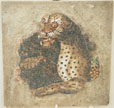 Mosaic
of a panther and a grape bushel. Mosaic
of a panther and a grape bushel. |
|
|
|
|
|
|
|
|
|
© All pictures are Copyright 2000 Grisel Gonzalez and Jeff
Prosise
|